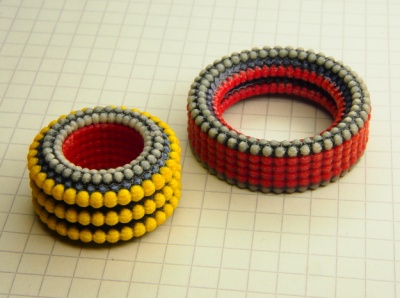Difference between revisions of "Atomically precise slide bearing"
From apm
(added image shoeing potential smooth-out & reference) |
m (typofix) |
||
| (4 intermediate revisions by the same user not shown) | |||
| Line 1: | Line 1: | ||
{{Stub}} | {{Stub}} | ||
'''Up: [[Atomically precise bearings]]''' | '''Up: [[Atomically precise bearings]]''' | ||
| − | [[File:Strained-shell-sleeve-bearing.gif|300px|thumb|right|A simulation of a ''' | + | [[File:Strained-shell-sleeve-bearing.gif|300px|thumb|right|A simulation of a '''superlubricating strained shell sleeve bearing'''. Author Eric K. Drexler]] |
[[File:0315bearingSums.gif|thumb|400px|Graphic by Eric K. Drexler -- Citation: "Symmetric molecular bearings can exhibit low energy barriers that are insensitive to details of the potential energy function" <ref name="pdrag"> '''Drag mechanisms in symmetrical sleeve bearings:''' Drexler, K. E. (1992) ''[[Nanosystems]]: Molecular Machinery, Manufacturing, and Computation.'' Wiley/Interscience, pp.290–293.</ref>]] | [[File:0315bearingSums.gif|thumb|400px|Graphic by Eric K. Drexler -- Citation: "Symmetric molecular bearings can exhibit low energy barriers that are insensitive to details of the potential energy function" <ref name="pdrag"> '''Drag mechanisms in symmetrical sleeve bearings:''' Drexler, K. E. (1992) ''[[Nanosystems]]: Molecular Machinery, Manufacturing, and Computation.'' Wiley/Interscience, pp.290–293.</ref>]] | ||
| + | [[File:Drexlers Big Bearing - photo of 3D printed model.JPG|thumb|400px|Erik K. Drexlers superlubricating "big bearing" - This is a photo of a 3D printed model. See: http://www.thingiverse.com/thing:631715]] | ||
Atomically precise slide bearings are bearings with: | Atomically precise slide bearings are bearings with: | ||
| Line 34: | Line 35: | ||
* [[Superlubricity]] | * [[Superlubricity]] | ||
* [[Absence of wear in atomically precise bearings]] | * [[Absence of wear in atomically precise bearings]] | ||
| + | * Deliberate inclusion of [[snapback]] elements can make an intentional high friction [[damper element]] | ||
| + | ---- | ||
| + | * [[Snapback]] | ||
| + | * [[Negative pressure bearings]] | ||
| + | |||
| + | == External links == | ||
| + | |||
| + | * Wikipedia: [https://en.wikipedia.org/wiki/Plain_bearing Plain bearing] (aka sleeve bearing) | ||
= References = | = References = | ||
Latest revision as of 13:49, 18 September 2022
Up: Atomically precise bearings

Graphic by Eric K. Drexler -- Citation: "Symmetric molecular bearings can exhibit low energy barriers that are insensitive to details of the potential energy function" [1]

Erik K. Drexlers superlubricating "big bearing" - This is a photo of a 3D printed model. See: http://www.thingiverse.com/thing:631715
Atomically precise slide bearings are bearings with:
- all surfaces being atomically precise and sufficiently nonreactive (See: nanoscale passivation)
- atomic bumpiness tuned for incommensurability – See: superlubricity
- dry running – no lubricants – (atoms in lubricants would be like gravel at these scales)
- no hollow spaces where dirt could get caught in & (redundantly) typically operating in a sealed PPV environment
Contents
Pros & Cons
PROs / Advantages:
- can be very small and compact
- can have extremely low friction for small speeds 1mm/s and below
Note: Choosing slow speeds in productive nanosystems is a viable (and proposed) option due to
the scaling law of higher throughput of smaller machinery.
CONs / Disadvantages:
- significant friction for moderate speeds ~1m/s
- very high friction for high speeds
Dynamic friction scales quadratically with speed. 10x speed 100x friction.
And vice-versa as the flip side of the coin.
2 Strategies for reducing friction for higher speeds – in bigger bearings
The design principle of Infinitesimal bearings can help for higher speeds
but going for atomically precise roller gearbearings too in the case of larger scale bearings
(assembly level 2 and above in productive nanosystems) may be advisable.
Related
- Examples of diamondoid molecular machine elements
- Alternative: Atomically precise roller gearbearings
- Infinitesimal bearings
- Superlubricity
- Absence of wear in atomically precise bearings
- Deliberate inclusion of snapback elements can make an intentional high friction damper element
External links
- Wikipedia: Plain bearing (aka sleeve bearing)
References
- ↑ Drag mechanisms in symmetrical sleeve bearings: Drexler, K. E. (1992) Nanosystems: Molecular Machinery, Manufacturing, and Computation. Wiley/Interscience, pp.290–293.
